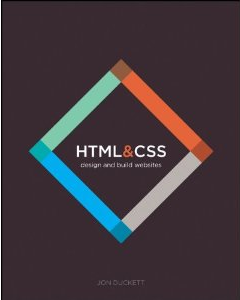Book review: HTML & CSS
 It had been a while since I’d read a book that didn’t have to do with JavaScript or something very computer-sciency, so when I was asked to review HTML & CSS: Design and Build Websites by Jon Duckett, I was interested to see how these books have changed. I learned HTML back in 1996, and honestly haven’t picked up another book on the subject since that time.
It had been a while since I’d read a book that didn’t have to do with JavaScript or something very computer-sciency, so when I was asked to review HTML & CSS: Design and Build Websites by Jon Duckett, I was interested to see how these books have changed. I learned HTML back in 1996, and honestly haven’t picked up another book on the subject since that time.
My first impression of the book is that it’s beautiful. The text is large and the pages are colorful, making it very easy to thumb through when in a hurry. When I wasn’t in a hurry and sat down to read it, I found that the book almost told the entire story through pictures. The words are there and technically correct, but it’s the visuals in the book that really communicate information to the reader.
I admired Duckett’s approach to this book. He completely dispels with the buzzwords that glitter so many books these days. There’s mention of HTML5 and CSS3, for sure, but it’s done in such a way that it doesn’t seem gimmicky or hyped. The title of the book itself is evidence of this. Duckett clearly doesn’t want you thinking about HTML 4 vs. HTML5 or CSS 2 vs. CSS3. Instead, he wants you to understand the concepts that link together web technology and good design. Some of that is done with HTML 4 and CSS 2 while some is done with HTML5 and CSS3.
This book is really targeted at beginners without a technical background, and it does an exceptional job in serving this audience. The approach is perhaps the gentlest introduction to the concept of web programming that I’ve ever encountered. So gentle, in fact, I think that almost anyone could pick up this book and start to make a simple web page relatively quickly. It takes you right from creating your HTML file with a text editor, through learning HTML and CSS, all the way to deploying your file and adding Google Analytics.
Sprinkled throughout the book are useful tidbits about typography, contrast, design concepts, and even how multimedia plugins such as Flash work in conjunction with a web page. The very visual nature of the book makes picking up these concepts easy, as every piece of code is accompanied with a diagram, figure, or screenshot showing the result.
If you’re an experienced web developer, you’ll probably want to pass on this book since it will be far too basic. However, if you’re looking for a good book to introduce web development to an inexperienced web developer, or even someone who has no experience, then this book is a great place to start.
Disclaimer: Any viewpoints and opinions expressed in this article are those of Nicholas C. Zakas and do not, in any way, reflect those of my employer, my colleagues, Wrox Publishing, O'Reilly Publishing, or anyone else. I speak only for myself, not for them.





